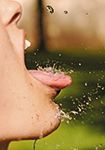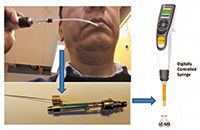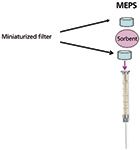Saliva Sampling
Mohamed Abdel-Rehim, professor of analytical chemistry at Stockholm University in Stockholm, Sweden, spoke to Bethany Degg of The Column about a novel approach to determine drug intake using saliva samples.
Mohamed Abdel-Rehim, professor of analytical chemistry at Stockholm University in Stockholm, Sweden, spoke to Bethany Degg of The Column about a novel approach to determine drug intake using saliva samples.
Q: What are your main research interests?
(PHOTO CREDIT: AKRIS/GETTY IMAGES)

A. My research interests have now developed into the following areas: The screening and detection of drugs and metabolites in saliva; the screening and identification of biomarkers in saliva and breath for early diagnostic purposes; the formulation of new drugs for easy administration to children and older people; the development of new sampling methods for saliva and breath; and the development of new chromatography sorbent material such as monoliths and molecular imprinted polymers for liquid chromatography (LC) and solid-phase extraction (SPE).
Q: Why did you select saliva as a sampling material to determine drug intake?
A. Saliva is quicker and less invasive to sample from patients than plasma, therefore making it suitable for children and elderly adults. Another important advantage is that there is a lower concentration of proteins in saliva than in plasma, which decreases potential drug binding to proteins. It is widely known that human saliva consists of 99.5% water and the remaining 0.5% consists of electrolytes, glycoproteins, enzymes, and antibacterial compounds. In addition, drugs and their metabolites can be detected at different concentrations within saliva. Our preliminary results indicate that the pharmacokinetic curve of the local anesthetic lidocaine (used as a model analyte) in saliva is similar to those in plasma samples - the only difference is that the concentration levels are lower in saliva than in plasma.1
There have recently been significant developments in the understanding of the target drugs and their pharmacokinetics in oral fluid, but the collection of an exact volume of saliva is not sufficiently accurate. Therefore, the development of new sampling methods for saliva samples is needed.
Q: What novel approach did your group take to sample saliva?
Figure 1: A picture of MEPS-eVol set with catheter used for saliva sampling.

A. In this method we used our innovative microextraction by packed sorbent (MEPS) for sampling and for sample pre-treatment of saliva. Small sample volumes of 100 microlitres or less can be handled. The method is easy, of low cost, and "greener". We used an automated analytical micro syringe and a MEPS to collect and handle saliva samples. The method was performed to screen and determine levels of lidocaine, in human saliva samples. In our method a semi-automated MEPS syringe was attached to a catheter to aspirate saliva. A sample of 100 µL or more can be taken directly from the mouth. The saliva was then dispensed through the MEPS sorbent for extraction (Figure 1).
Sometimes saliva can be difficult to work with. This is because saliva stimulated by sympathetic innervation can be thick. We performed our method in two steps: First, we collected saliva using the syringe with a catheter, and then we pushed the saliva through the MEPS needle for the extraction step (Figure 1). Now we are working with a newly developed syringe with two catheter inputs - one for saliva and one for washing and elution solutions - using a wider catheter and a syringe equipped with a micro-valve.
Q: How did you develop MEPS as a sample preparation method for biological samples? What is the story behind it?
A. There is a long history behind the development of MEPS. From 2000–2002, when we were testing solid-phase microextraction (SPME) in bioanalysis, we saw that the robustness of SPME was not good enough for the handling of plasma samples. The most problematic issue of SPME in quantitative bioanalysis is the fibre lifetime. This can drop from 100 extractions to less than 20 depending on the matrix (plasma or blood) and additives used. In addition, the quality of the fibre can differ from batch to batch.2
Figure 2: Diagram to demonstrate principle of MEPS.

I then considered SPE: It is a more robust technology but could it be miniaturized and used with on-line analytical instruments such as gas chromatography (GC) or LC systems? One week later I came up with an idea. I placed silica sorbent between two frits and fitted it into a syringe barrel (Figure 2). I first tried to perform MEPS manually with lidocaine diluted in a water sample, passing the water sample up and down through the C18 silica sorbent several times via the syringe. After that I eluted it with a few microlitres of acetonitrile directly into the GC–MS system.
After a short time I got a lidocaine peak. I was very pleased because it worked the first time and in just a few seconds. When I presented the MEPS to my colleagues, they were astonished that no one had ever thought about it before. The technique provides speed and simplifies the sample preparation process. Later MEPS was patented through AstraZeneca.3 My group and I have performed many experiments with MEPS using different matrices such as water, plasma, urine, blood, and saliva. MEPS has now been automated and we now have MEPS on-line for multiple uses and for single use. Today, many different researchers use the MEPS technique.4
Q: What steps are you taking on this project next?
A. We have a number of goals ahead. I want to gain further insights into the relationship between drug concentration in saliva and in plasma using different groups of drugs. I am also interested in investigating saliva as a sampling material for biomarker screening. In addition, I am interested in finding a new sampling technique for saliva. We have recently been working with dried saliva spots (DSS). I think that we are the first to use this and the primary results have been promising.
Q: What is dried saliva spot sampling? What are the potential applications?
A. We used a plastic micro-syringe with a catheter. A 100 µL measure of saliva was taken from the mouth and 50 µL placed on filter paper; 50 µL is reserved for analysis rerun. The saliva on the filter paper was extracted with 150 µL acetonitrile. The acetonitrile was then injected into the LC–MS system. The method is very easy to handle and is much easier than dried blood spot (DBS) analysis. It can be used in the screening and determination of drugs, metabolites, and hormones, and in drug testing.
Q: What are the challenges you are facing on this project?
A. The challenge now is to increase the method sensitivity. This can be done by increasing the sample volume or by using more sensitive instrumentation.
Q: What is your role as group leader of the National Research Center of Egypt?
A. I have built up a laboratory for pharmaceutical research. I have received two LC–MS–MS and one GC–MS systems, in addition to instruments from AstraZeneca and other companies in Sweden. Currently we have a group of five scientists working in this laboratory: one associate professor, two doctors, and two graduate students. Our research aims to design and synthesize new pro-drugs, and to investigate new formulations of known drugs for ease of use by children and older people.
References
1. M. Abdel-Rehim et al., J. Biomed. Chromatogr. 27(9), 1188–1191 (2013).
2. M. Abdel-Rehim, M. Andersson, E. Portelius, C. Norsten-Hoog, and L.G. Blomberg. Microcolumn Separations 13(8), 313–321 (2001).
3. M. Abdel-Rehim, PCT World Intellectual Property Organization, International Publication Number: WO 03/019149 A1 (2003).
4. M. Abdel-Rehim. J. Chromatogr. A 1217(16), 2569–2580 (2010).
Mohamed Abdel-Rehim

Mohamed Abdel-Rehim is a professor in analytical chemistry at Stockholm University (Stockholm, Sweden). In addition, he is a visiting professor at the National Research Center of Egypt. He has worked as a senior and a principal scientist at AstraZeneca R&D, Sodertalje, Sweden, from 1996 to 2011. He obtained his PhD in pharmaceutical science from Uppsala University, Sweden. Abdel-Rehim has published more than 225 articles including book and encyclopedia chapters, review articles, research papers, technical reports, and conference presentations. He specializes in drug development, bioanalysis, and sample preparation. He is the inventor of MEPS (microextraction by packed sorbent).
E-mail: mohamed.abdel-rehim@anchem.su.se
Website: www.anchem.su.se/index.php?option=com_content&view=article&id=35&Itemid=116&staffid=106/
This article is from The Column. The full issue can be found here: http://www.chromatographyonline.com/node/373202

A Novel LC–QTOF-MS DIA Method for Pesticide Quantification and Screening in Agricultural Waters
May 8th 2025Scientists from the University of Santiago de Compostela developed a liquid chromatography quadrupole time-of-flight mass spectrometry (LC–QTOF-MS) operated in data-independent acquisition (DIA) mode for pesticide quantification in agriculturally impacted waters.
Investigating 3D-Printable Stationary Phases in Liquid Chromatography
May 7th 20253D printing technology has potential in chromatography, but a major challenge is developing materials with both high porosity and robust mechanical properties. Recently, scientists compared the separation performances of eight different 3D printable stationary phases.

.png&w=3840&q=75)

.png&w=3840&q=75)



.png&w=3840&q=75)



.png&w=3840&q=75)








